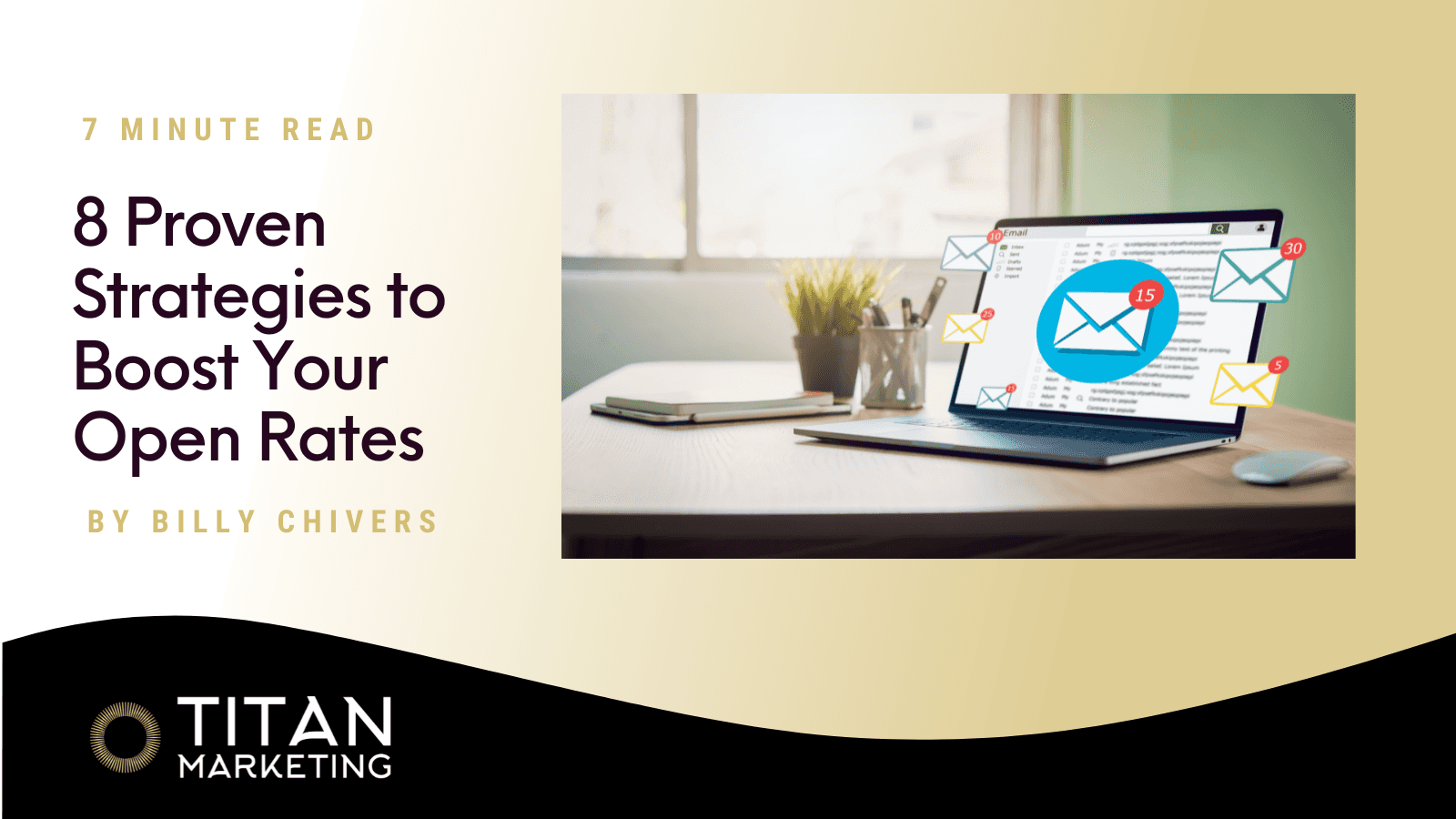
Blog
August 9, 2024

Blog
August 9, 2024

Blog
August 9, 2024
You've spent time & effort designing beautiful campaigns. Now you need to get customers to read them! Read on for proven tips to maximise opens.
Boosting email open rates is crucial for maximising the impact of your email marketing campaigns.
A higher open rate means more recipients are engaging with your content, which leads to increased sales and customer retention.
This blog post outlines proven strategies to help you optimise your email open rates using Klaviyo.
Understanding Open Rates
Definition: The ratio of total email opens to the total number of emails successfully delivered to recipients' inboxes. For example, if you send out 1,000 emails and 200 are opened, your open rate is 20%. This metric serves as an initial indicator of how well your email content, subject lines, and overall strategy are performing.
Importance: High open rates are indicative of effective email marketing strategies. They suggest that your emails are compelling enough to capture the attention of your audience amidst a crowded inbox. This engagement is critical for several reasons:
Audience Engagement: High open rates reflect that your audience finds value in your communications, which is essential for maintaining ongoing engagement and building customer relationships.
Brand Trust and Recognition: Consistently high open rates can enhance brand loyalty, as recipients come to expect and appreciate your emails.
Increased Sales Opportunities: The more recipients who open your emails, the greater the likelihood that they will click through to your website or landing page, leading to increased sales and conversions.
Insightful Feedback: Analysing open rates can provide valuable feedback on the effectiveness of your subject lines and the optimal times to send emails, helping you refine your strategies for better results.
Key Strategies for Boosting Open Rates
1. Personalisation (not just first name...)
Importance: Personalised emails are significantly more effective at capturing the recipient's attention compared to generic emails. This includes first name, but goes beyond that to segment by purchase interest & history. Segmented emails significantly enhance engagement by driving relevance & connection, leading to 30% more opens and 50% more click throughs compared to unsegmented ones (Hubspot).
How to Implement in Klaviyo:
Use the Recipient’s First Name in the Subject Line:
Go to the "Campaigns" tab in Klaviyo.
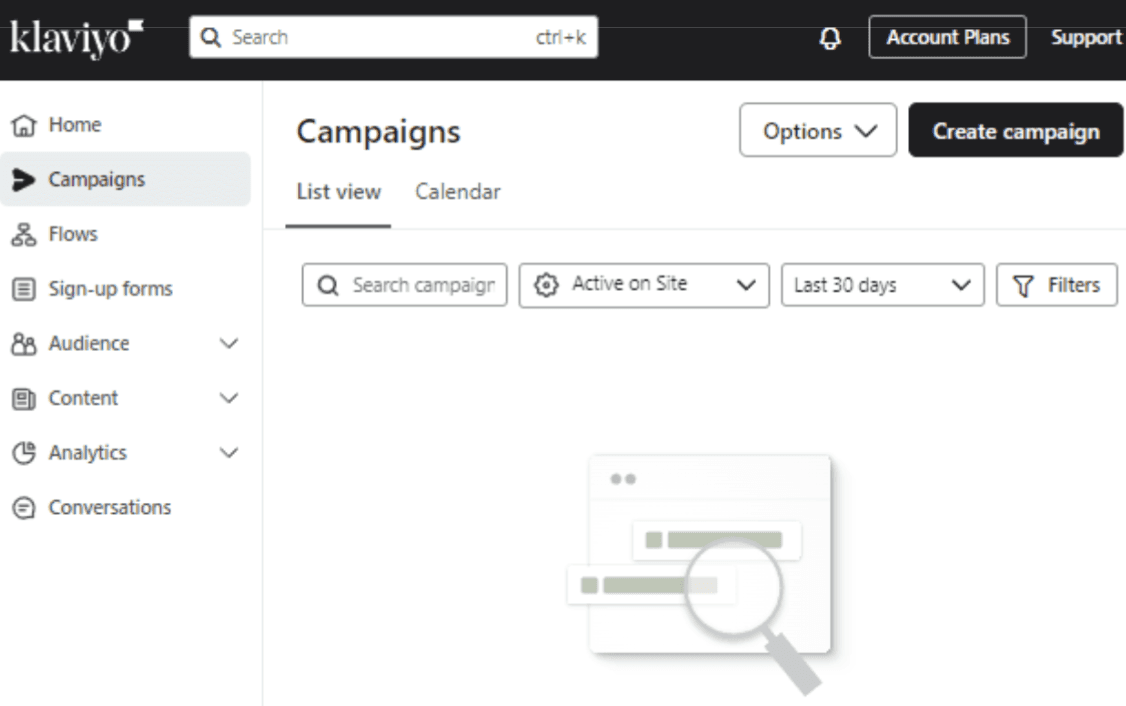
Click on "Create Campaign" and select "Email".
In the email setup, click on "Add Recipients" and choose the appropriate list or segment.

In the subject line field, insert the dynamic tag for the recipient’s first name by clicking on the "Personalise" button and selecting "First Name". Example: "Hey {{ first_name }}, check out our new collection!"
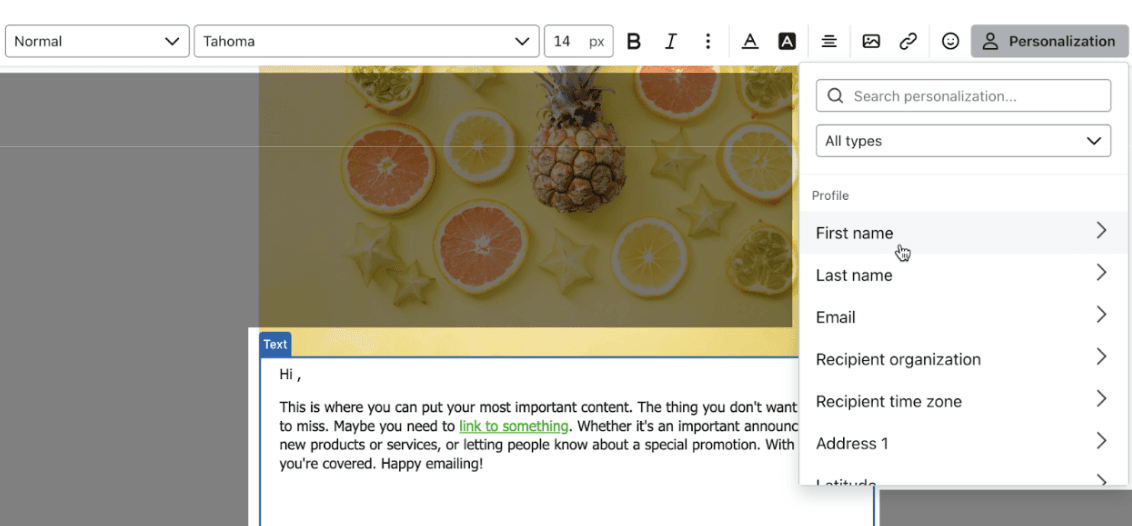
Segment by purchase history & interest:
Open Klaviyo and log in with your credentials.
Create a New Segment. From the main dashboard, click on the "Lists & Segments" tab on the left-hand navigation menu.
Click on the "Create List / Segment" button. Select "Segment" from the options provided.
Set Conditions Based on Purchase & Interest History, such as the below.
Tailor the Subject Line accordingly e.g. for people interested in gifts, ‘Top Mothers day gifts for 2024’.

Review the conditions and click "Preview" to see the list of customers who meet the criteria. Click "Create Segment" to save.
Click here for more details about segmentation strategies.
2. Optimise Send Time
Importance: Sending emails at the right time significantly impacts open rates, making timing a critical factor in email marketing success. According to GetResponse's 2019 email analysis, emails sent in the morning between 9-10 AM saw an average open rate increase of 21.35%. At noon, the open rate peaked at 22.09% between 1-2 PM. However, the open rate slightly decreased in the afternoon to 20.74%. However this depends on a brand by brand basis, so remember to test it!
How to Implement in Klaviyo:
Go to the "Campaigns" tab and click on "Create Campaign".
In the campaign setup, select "Smart Send Time" under the scheduling options.
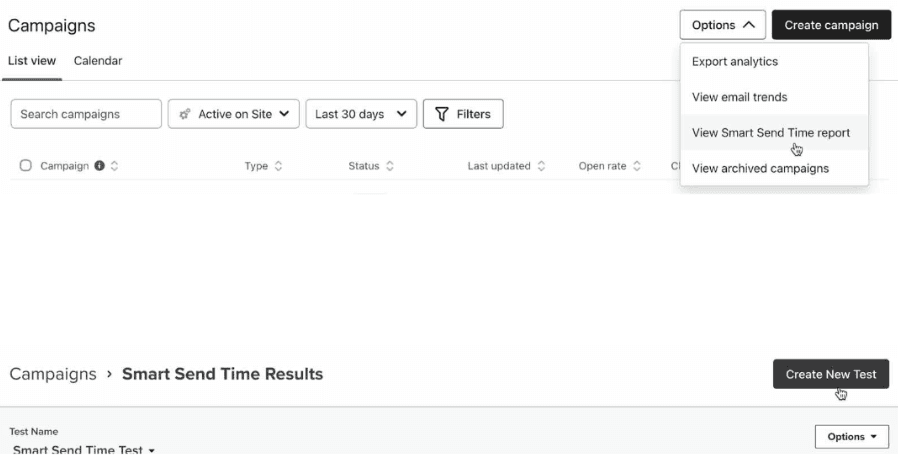
Klaviyo will analyse past send data to determine the optimal send time for your audience.
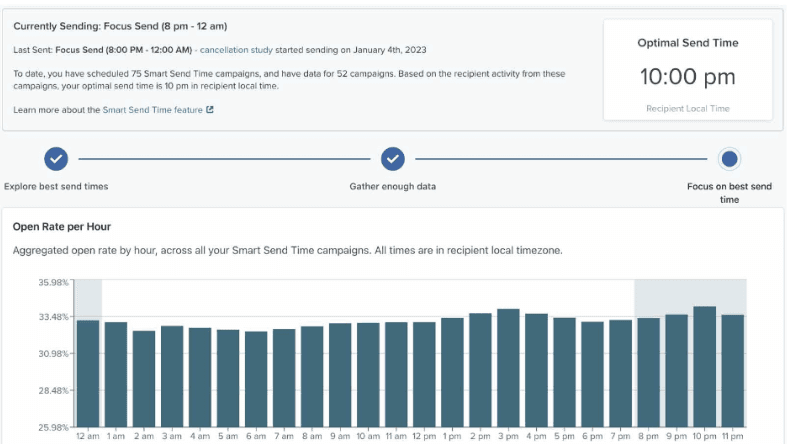
Follow the recommendations to schedule your email sends (Klaviyo).
3. Leverage Curiosity in the Subject Line
Importance: Using email subject lines that spark curiosity can dramatically boost engagement with your brand. Brands that incorporate interactive content in their subject lines see conversion rates soar to 70%, compared to just 36% for static content, nearly doubling conversions. This technique effectively grabs recipients' attention and motivates them to delve deeper into your emails, enhancing overall interaction and interest.(OptinMonster)
How to Implement:
Use Actionable Language and Create a Sense of Urgency or Curiosity:
In the "Campaigns" tab, click on "Create Campaign" and select "Email".
In the subject line field, craft a message that sparks curiosity.
Example: "You won’t believe what’s inside!" or "Last chance to grab this deal!"
Test Different Approaches and Monitor Results:
Use Klaviyo’s A/B testing feature to test different subject lines.
Set up multiple variations and send them to different segments of your list.
Monitor the open rates and choose the best-performing subject line.
4. Use Preview Text Correctly
Importance: Preview text complements the subject line and can entice recipients to open the email. Emails with optimised preview text have higher open rates as it provides an additional incentive for the recipient to open the email and engage with the content. A recent study by Litmus revealed that using informative or optimised preview text can boost email open rates by up to 45%. (TSRMatters)
How to Implement in Klaviyo:
When creating an email, find the preview text field below the subject line field.

Write a preview text that adds context or value to the subject line.
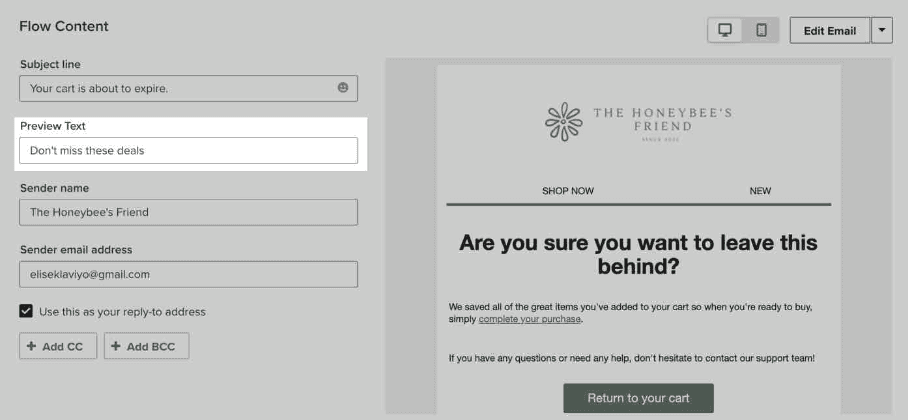
Keep it concise, ideally 40-50 characters, to ensure visibility on mobile devices
Use the "Preview" feature in Klaviyo to see how your email looks on different devices, and is visible on desktop & mobile.
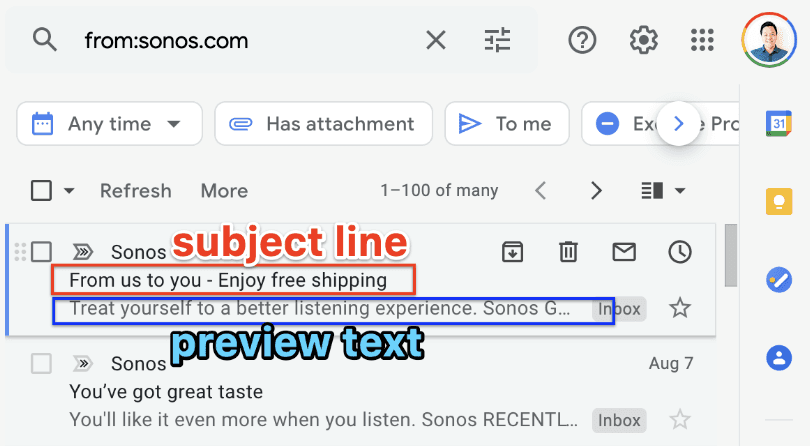
5. Clean Your List (Unengaged & Soft Bounce)
Importance: Regularly cleaning your email list improves deliverability and open rates. A clean list reduces unengaged subscribers and chronic soft bounces, ensuring poor-quality subscribers are removed. This minimises negative engagement & ensures your messages land in the inbox not spam, directly improving opens. Average bounce rates hover around 0.92% for soft bounces and 0.54% for hard bounces. (EmailListVerify)
Cleaning your email list by removing unengaged subscribers and soft bounces can significantly increase open rates. Engaging only the most interested subscribers improves relevance and deliverability. Studies indicate that this practice can boost open rates by 28% to 40%, making your email marketing more effective and reaching a more engaged audience.
How to Implement in Klaviyo:
Set up your unengaged list to clean:
Go to the "Lists & Segments" tab and create a new segment.
Define criteria to identify unengaged subscribers (e.g., no opens or clicks in the last 90 days).
Review this segment regularly and move unengaged subscribers to a re-engagement campaign or remove them from your list.
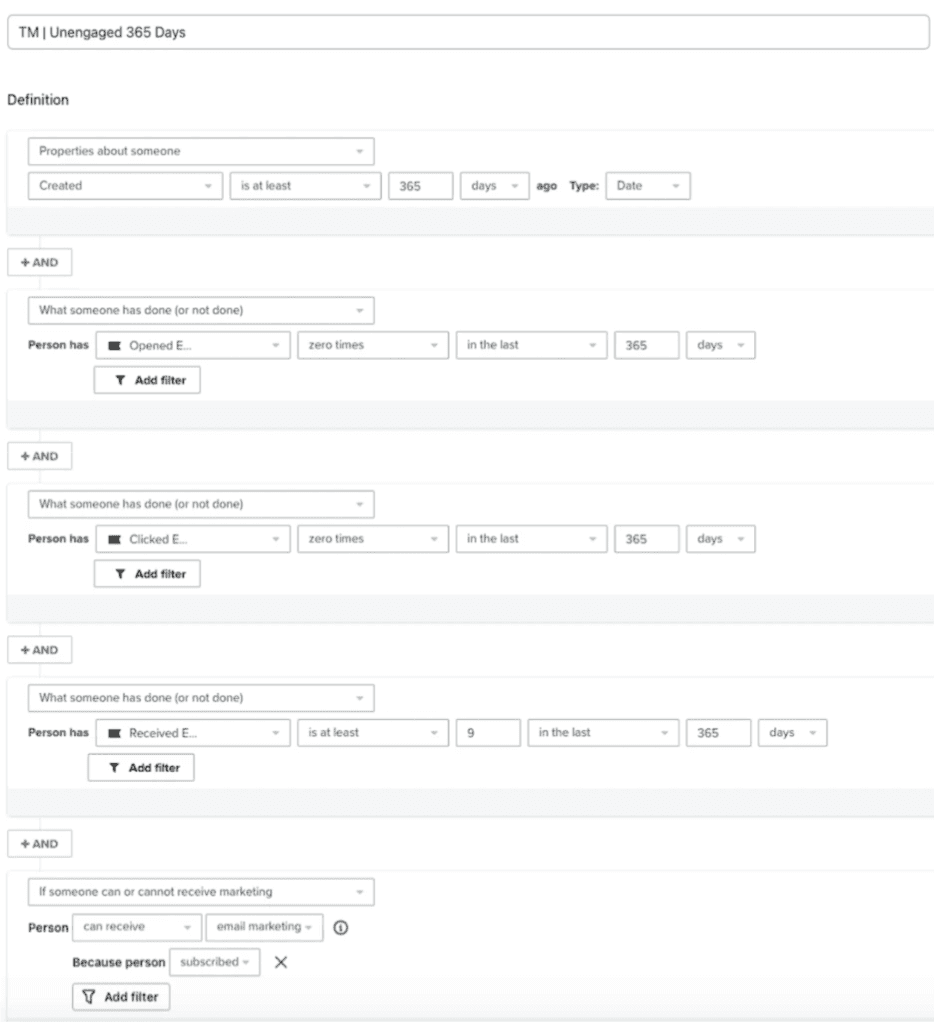
Set up your soft bounce list to clean:
Create a Soft Bounce Segment: Navigate to "Lists & Segments" and create a new segment.
Set conditions to include profiles that have bounced emails at least four times in the last 90 days and are eligible to receive marketing emails.
Review and Save the Segment: Name your segment (e.g., "Chronic Soft Bounces") and save it. Review the segment list to ensure it captures all relevant profiles.
Suppress or Exclude Identified Profiles: Suppress these profiles to prevent them from receiving future emails or exclude them from campaigns by adjusting your campaign settings.
Monitor and Maintain: Regularly update the segment to ensure continued list hygiene and improved deliverability by monitoring soft bounces and taking appropriate actions.

6. Avoid 'Spammy' Language
Importance: Using 'spammy' words in your email content can significantly increase the likelihood of your messages being filtered into the spam folder, thereby reducing their visibility and effectiveness. According to Lemlist, emails containing certain trigger words or phrases often face stricter scrutiny by spam filters, which can reduce their deliverability and open rates. Furthermore, it's noted that up to 20% of all marketing emails end up in spam folders, highlighting the importance of avoiding spam triggers to maintain high open rates and effective communication.
Source: Omeda
How to Implement:
Avoid Using Excessive Capitalisation or Too Many Exclamation Marks.
Steer Clear of Words and Phrases Commonly Associated with Spam:
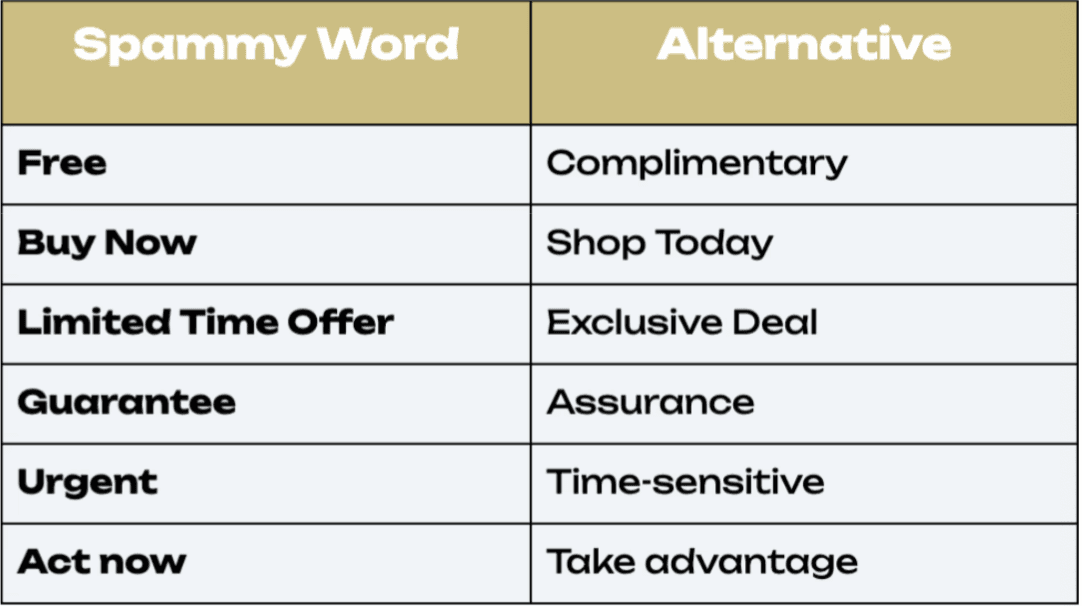
Test with Glockapps: GlockApps helps marketers avoid 'spammy' language by analyzing email content for words and phrases that could trigger spam filters. It provides detailed reports and suggestions to improve deliverability, ensuring your emails reach the inbox and engage recipients effectively. For more information, visit GlockApps.
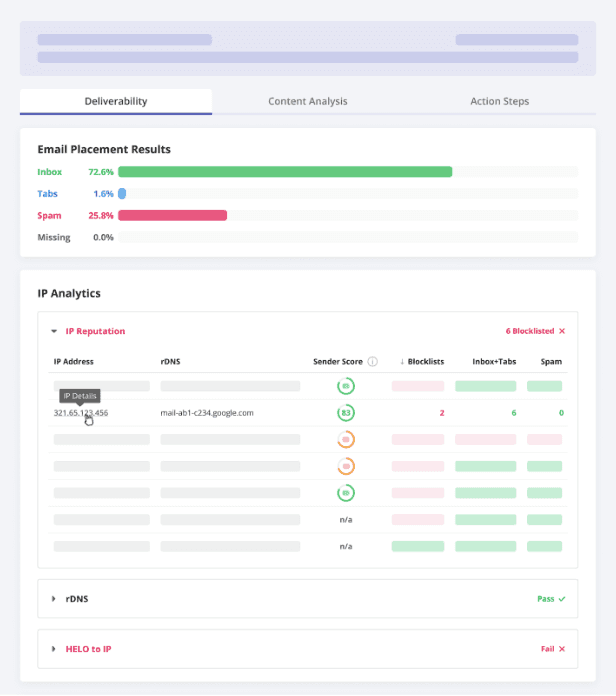

7. BIMI (Brand Indicators for Message Identification)
Importance: BIMI is an emerging security technology that enhances email authentication and builds trust with recipients. By displaying your brand logo next to your messages in recipients’ inboxes, BIMI helps verify the legitimacy of your emails. Studies reveal that companies using BIMI have seen their open rates rise by an average of 39%. This is due to the significant boost in brand recall, with an average recall rate of 44% higher than those that did not use this technology.(Palisade)
How to Implement:
Authenticate Your Domain Using DKIM, SPF, and DMARC:
SPF (Sender Policy Framework): Ensures emails are sent from authorised servers.
DKIM (DomainKeys Identified Mail): Provides a digital signature to verify that the email content hasn’t been altered.
DMARC (Domain-based Message Authentication, Reporting & Conformance): Aligns SPF and DKIM to improve email security and prevent phishing.
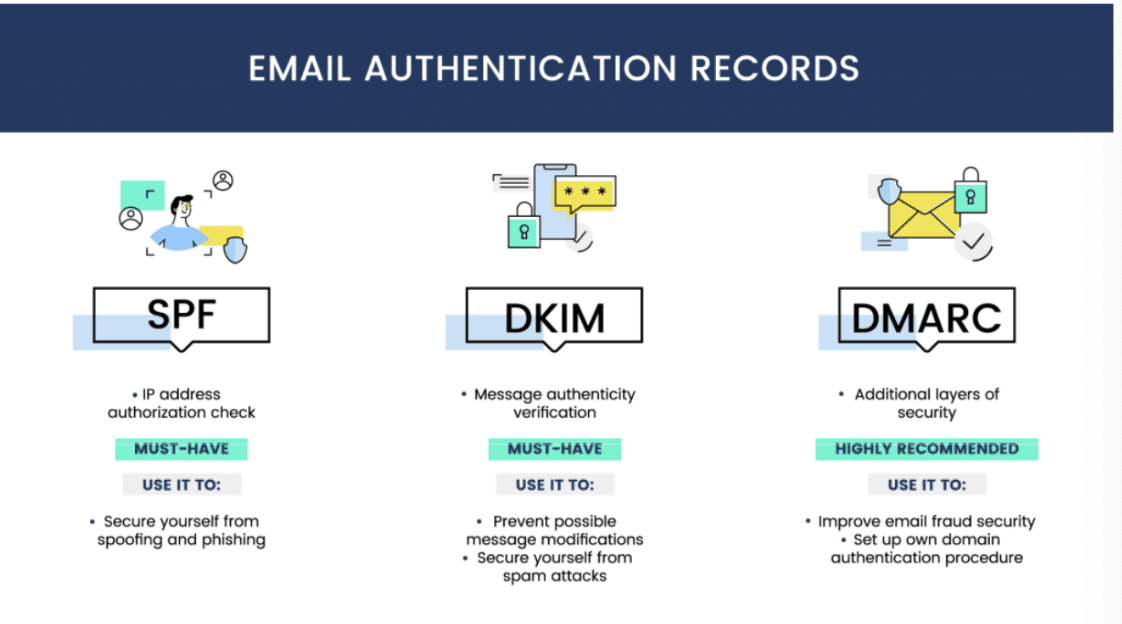
Source: SecurityBoulevard
Follow the steps outlined in Litmus's blog post (click here). You will need to:
Obtain a Verified Mark Certificate (VMC) from providers like DigiCert or Entrust.
Produce an SVG Version of Your Logo
Publish a BIMI Record in your domain's DNS records
8. Split Testing Sender Names
Importance: The sender name significantly influences email open rates. A/B split testing helps identify the most effective sender names. Testing different sender names, such as a person’s name versus a brand name, can show that using a person’s name may result in a 0.53% higher open rate and a 0.23% higher click-through rate.(Campaign Monitor)
How to implement:
Create an Email Campaign: Log in to Klaviyo and start a new email campaign.
Set Up Campaign Content: Fill out all fields with your control email’s information, labeling it as “Version A.”
Define Test Variable: Identify and change only one variable for the A/B test - Sender Name.
Create Version B: Duplicate the campaign and modify the selected variable for “Version B.”
Configure A/B Test Settings: Set the split percentage for your audience (e.g., 50% for each version).
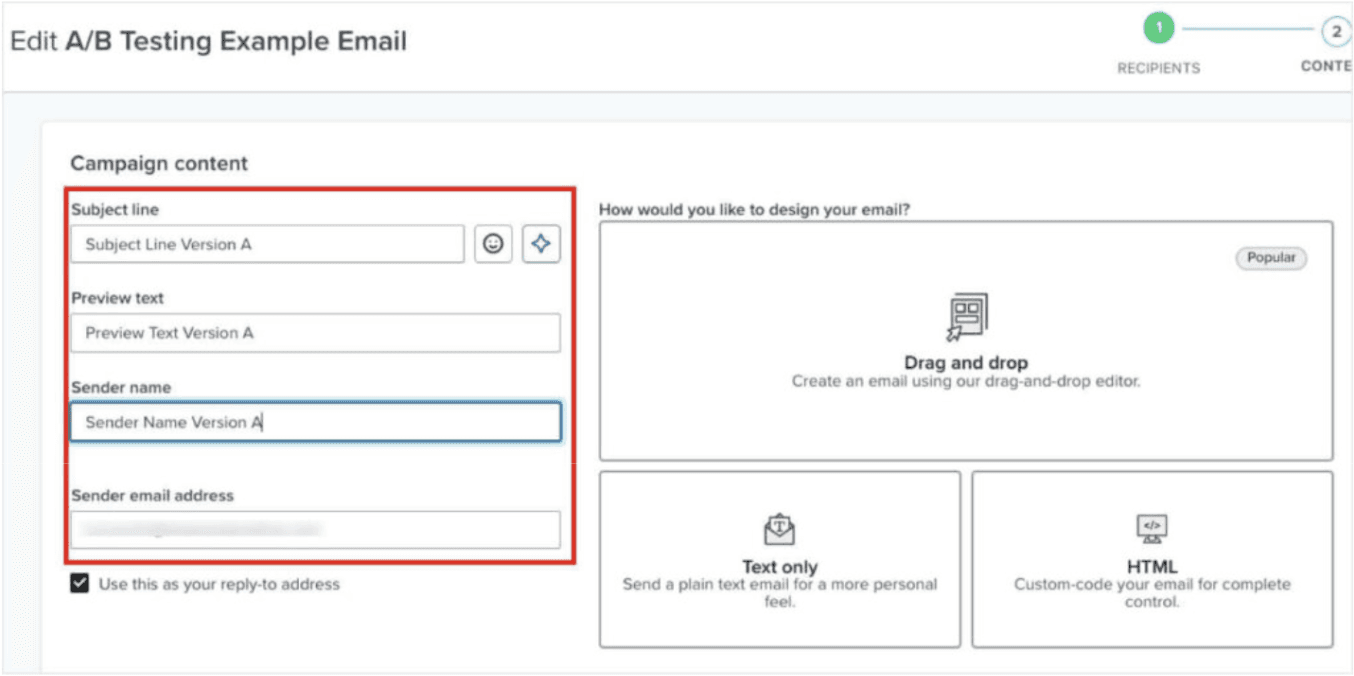
Source: OptinMonster
Conclusion
Implementing these strategies can significantly boost your email open rates in Klaviyo, leading to higher engagement and increased sales. Regularly testing and refining your approach based on data insights will ensure continued improvement in your email marketing performance.
Are your email open rates lower than expected?
Schedule an audit today & we'll show you how to craft subject lines & preview texts that guarantee opens.
Boosting email open rates is crucial for maximising the impact of your email marketing campaigns.
A higher open rate means more recipients are engaging with your content, which leads to increased sales and customer retention.
This blog post outlines proven strategies to help you optimise your email open rates using Klaviyo.
Understanding Open Rates
Definition: The ratio of total email opens to the total number of emails successfully delivered to recipients' inboxes. For example, if you send out 1,000 emails and 200 are opened, your open rate is 20%. This metric serves as an initial indicator of how well your email content, subject lines, and overall strategy are performing.
Importance: High open rates are indicative of effective email marketing strategies. They suggest that your emails are compelling enough to capture the attention of your audience amidst a crowded inbox. This engagement is critical for several reasons:
Audience Engagement: High open rates reflect that your audience finds value in your communications, which is essential for maintaining ongoing engagement and building customer relationships.
Brand Trust and Recognition: Consistently high open rates can enhance brand loyalty, as recipients come to expect and appreciate your emails.
Increased Sales Opportunities: The more recipients who open your emails, the greater the likelihood that they will click through to your website or landing page, leading to increased sales and conversions.
Insightful Feedback: Analysing open rates can provide valuable feedback on the effectiveness of your subject lines and the optimal times to send emails, helping you refine your strategies for better results.
Key Strategies for Boosting Open Rates
1. Personalisation (not just first name...)
Importance: Personalised emails are significantly more effective at capturing the recipient's attention compared to generic emails. This includes first name, but goes beyond that to segment by purchase interest & history. Segmented emails significantly enhance engagement by driving relevance & connection, leading to 30% more opens and 50% more click throughs compared to unsegmented ones (Hubspot).
How to Implement in Klaviyo:
Use the Recipient’s First Name in the Subject Line:
Go to the "Campaigns" tab in Klaviyo.

Click on "Create Campaign" and select "Email".
In the email setup, click on "Add Recipients" and choose the appropriate list or segment.

In the subject line field, insert the dynamic tag for the recipient’s first name by clicking on the "Personalise" button and selecting "First Name". Example: "Hey {{ first_name }}, check out our new collection!"

Segment by purchase history & interest:
Open Klaviyo and log in with your credentials.
Create a New Segment. From the main dashboard, click on the "Lists & Segments" tab on the left-hand navigation menu.
Click on the "Create List / Segment" button. Select "Segment" from the options provided.
Set Conditions Based on Purchase & Interest History, such as the below.
Tailor the Subject Line accordingly e.g. for people interested in gifts, ‘Top Mothers day gifts for 2024’.

Review the conditions and click "Preview" to see the list of customers who meet the criteria. Click "Create Segment" to save.
Click here for more details about segmentation strategies.
2. Optimise Send Time
Importance: Sending emails at the right time significantly impacts open rates, making timing a critical factor in email marketing success. According to GetResponse's 2019 email analysis, emails sent in the morning between 9-10 AM saw an average open rate increase of 21.35%. At noon, the open rate peaked at 22.09% between 1-2 PM. However, the open rate slightly decreased in the afternoon to 20.74%. However this depends on a brand by brand basis, so remember to test it!
How to Implement in Klaviyo:
Go to the "Campaigns" tab and click on "Create Campaign".
In the campaign setup, select "Smart Send Time" under the scheduling options.

Klaviyo will analyse past send data to determine the optimal send time for your audience.

Follow the recommendations to schedule your email sends (Klaviyo).
3. Leverage Curiosity in the Subject Line
Importance: Using email subject lines that spark curiosity can dramatically boost engagement with your brand. Brands that incorporate interactive content in their subject lines see conversion rates soar to 70%, compared to just 36% for static content, nearly doubling conversions. This technique effectively grabs recipients' attention and motivates them to delve deeper into your emails, enhancing overall interaction and interest.(OptinMonster)
How to Implement:
Use Actionable Language and Create a Sense of Urgency or Curiosity:
In the "Campaigns" tab, click on "Create Campaign" and select "Email".
In the subject line field, craft a message that sparks curiosity.
Example: "You won’t believe what’s inside!" or "Last chance to grab this deal!"
Test Different Approaches and Monitor Results:
Use Klaviyo’s A/B testing feature to test different subject lines.
Set up multiple variations and send them to different segments of your list.
Monitor the open rates and choose the best-performing subject line.
4. Use Preview Text Correctly
Importance: Preview text complements the subject line and can entice recipients to open the email. Emails with optimised preview text have higher open rates as it provides an additional incentive for the recipient to open the email and engage with the content. A recent study by Litmus revealed that using informative or optimised preview text can boost email open rates by up to 45%. (TSRMatters)
How to Implement in Klaviyo:
When creating an email, find the preview text field below the subject line field.

Write a preview text that adds context or value to the subject line.

Keep it concise, ideally 40-50 characters, to ensure visibility on mobile devices
Use the "Preview" feature in Klaviyo to see how your email looks on different devices, and is visible on desktop & mobile.

5. Clean Your List (Unengaged & Soft Bounce)
Importance: Regularly cleaning your email list improves deliverability and open rates. A clean list reduces unengaged subscribers and chronic soft bounces, ensuring poor-quality subscribers are removed. This minimises negative engagement & ensures your messages land in the inbox not spam, directly improving opens. Average bounce rates hover around 0.92% for soft bounces and 0.54% for hard bounces. (EmailListVerify)
Cleaning your email list by removing unengaged subscribers and soft bounces can significantly increase open rates. Engaging only the most interested subscribers improves relevance and deliverability. Studies indicate that this practice can boost open rates by 28% to 40%, making your email marketing more effective and reaching a more engaged audience.
How to Implement in Klaviyo:
Set up your unengaged list to clean:
Go to the "Lists & Segments" tab and create a new segment.
Define criteria to identify unengaged subscribers (e.g., no opens or clicks in the last 90 days).
Review this segment regularly and move unengaged subscribers to a re-engagement campaign or remove them from your list.

Set up your soft bounce list to clean:
Create a Soft Bounce Segment: Navigate to "Lists & Segments" and create a new segment.
Set conditions to include profiles that have bounced emails at least four times in the last 90 days and are eligible to receive marketing emails.
Review and Save the Segment: Name your segment (e.g., "Chronic Soft Bounces") and save it. Review the segment list to ensure it captures all relevant profiles.
Suppress or Exclude Identified Profiles: Suppress these profiles to prevent them from receiving future emails or exclude them from campaigns by adjusting your campaign settings.
Monitor and Maintain: Regularly update the segment to ensure continued list hygiene and improved deliverability by monitoring soft bounces and taking appropriate actions.

6. Avoid 'Spammy' Language
Importance: Using 'spammy' words in your email content can significantly increase the likelihood of your messages being filtered into the spam folder, thereby reducing their visibility and effectiveness. According to Lemlist, emails containing certain trigger words or phrases often face stricter scrutiny by spam filters, which can reduce their deliverability and open rates. Furthermore, it's noted that up to 20% of all marketing emails end up in spam folders, highlighting the importance of avoiding spam triggers to maintain high open rates and effective communication.
Source: Omeda
How to Implement:
Avoid Using Excessive Capitalisation or Too Many Exclamation Marks.
Steer Clear of Words and Phrases Commonly Associated with Spam:

Test with Glockapps: GlockApps helps marketers avoid 'spammy' language by analyzing email content for words and phrases that could trigger spam filters. It provides detailed reports and suggestions to improve deliverability, ensuring your emails reach the inbox and engage recipients effectively. For more information, visit GlockApps.


7. BIMI (Brand Indicators for Message Identification)
Importance: BIMI is an emerging security technology that enhances email authentication and builds trust with recipients. By displaying your brand logo next to your messages in recipients’ inboxes, BIMI helps verify the legitimacy of your emails. Studies reveal that companies using BIMI have seen their open rates rise by an average of 39%. This is due to the significant boost in brand recall, with an average recall rate of 44% higher than those that did not use this technology.(Palisade)
How to Implement:
Authenticate Your Domain Using DKIM, SPF, and DMARC:
SPF (Sender Policy Framework): Ensures emails are sent from authorised servers.
DKIM (DomainKeys Identified Mail): Provides a digital signature to verify that the email content hasn’t been altered.
DMARC (Domain-based Message Authentication, Reporting & Conformance): Aligns SPF and DKIM to improve email security and prevent phishing.

Source: SecurityBoulevard
Follow the steps outlined in Litmus's blog post (click here). You will need to:
Obtain a Verified Mark Certificate (VMC) from providers like DigiCert or Entrust.
Produce an SVG Version of Your Logo
Publish a BIMI Record in your domain's DNS records
8. Split Testing Sender Names
Importance: The sender name significantly influences email open rates. A/B split testing helps identify the most effective sender names. Testing different sender names, such as a person’s name versus a brand name, can show that using a person’s name may result in a 0.53% higher open rate and a 0.23% higher click-through rate.(Campaign Monitor)
How to implement:
Create an Email Campaign: Log in to Klaviyo and start a new email campaign.
Set Up Campaign Content: Fill out all fields with your control email’s information, labeling it as “Version A.”
Define Test Variable: Identify and change only one variable for the A/B test - Sender Name.
Create Version B: Duplicate the campaign and modify the selected variable for “Version B.”
Configure A/B Test Settings: Set the split percentage for your audience (e.g., 50% for each version).

Source: OptinMonster
Conclusion
Implementing these strategies can significantly boost your email open rates in Klaviyo, leading to higher engagement and increased sales. Regularly testing and refining your approach based on data insights will ensure continued improvement in your email marketing performance.
Are your email open rates lower than expected?
Schedule an audit today & we'll show you how to craft subject lines & preview texts that guarantee opens.
You've spent time & effort designing beautiful campaigns. Now you need to get customers to read them! Read on for proven tips to maximise opens.
Boosting email open rates is crucial for maximising the impact of your email marketing campaigns.
A higher open rate means more recipients are engaging with your content, which leads to increased sales and customer retention.
This blog post outlines proven strategies to help you optimise your email open rates using Klaviyo.
Understanding Open Rates
Definition: The ratio of total email opens to the total number of emails successfully delivered to recipients' inboxes. For example, if you send out 1,000 emails and 200 are opened, your open rate is 20%. This metric serves as an initial indicator of how well your email content, subject lines, and overall strategy are performing.
Importance: High open rates are indicative of effective email marketing strategies. They suggest that your emails are compelling enough to capture the attention of your audience amidst a crowded inbox. This engagement is critical for several reasons:
Audience Engagement: High open rates reflect that your audience finds value in your communications, which is essential for maintaining ongoing engagement and building customer relationships.
Brand Trust and Recognition: Consistently high open rates can enhance brand loyalty, as recipients come to expect and appreciate your emails.
Increased Sales Opportunities: The more recipients who open your emails, the greater the likelihood that they will click through to your website or landing page, leading to increased sales and conversions.
Insightful Feedback: Analysing open rates can provide valuable feedback on the effectiveness of your subject lines and the optimal times to send emails, helping you refine your strategies for better results.
Key Strategies for Boosting Open Rates
1. Personalisation (not just first name...)
Importance: Personalised emails are significantly more effective at capturing the recipient's attention compared to generic emails. This includes first name, but goes beyond that to segment by purchase interest & history. Segmented emails significantly enhance engagement by driving relevance & connection, leading to 30% more opens and 50% more click throughs compared to unsegmented ones (Hubspot).
How to Implement in Klaviyo:
Use the Recipient’s First Name in the Subject Line:
Go to the "Campaigns" tab in Klaviyo.

Click on "Create Campaign" and select "Email".
In the email setup, click on "Add Recipients" and choose the appropriate list or segment.

In the subject line field, insert the dynamic tag for the recipient’s first name by clicking on the "Personalise" button and selecting "First Name". Example: "Hey {{ first_name }}, check out our new collection!"

Segment by purchase history & interest:
Open Klaviyo and log in with your credentials.
Create a New Segment. From the main dashboard, click on the "Lists & Segments" tab on the left-hand navigation menu.
Click on the "Create List / Segment" button. Select "Segment" from the options provided.
Set Conditions Based on Purchase & Interest History, such as the below.
Tailor the Subject Line accordingly e.g. for people interested in gifts, ‘Top Mothers day gifts for 2024’.

Review the conditions and click "Preview" to see the list of customers who meet the criteria. Click "Create Segment" to save.
Click here for more details about segmentation strategies.
2. Optimise Send Time
Importance: Sending emails at the right time significantly impacts open rates, making timing a critical factor in email marketing success. According to GetResponse's 2019 email analysis, emails sent in the morning between 9-10 AM saw an average open rate increase of 21.35%. At noon, the open rate peaked at 22.09% between 1-2 PM. However, the open rate slightly decreased in the afternoon to 20.74%. However this depends on a brand by brand basis, so remember to test it!
How to Implement in Klaviyo:
Go to the "Campaigns" tab and click on "Create Campaign".
In the campaign setup, select "Smart Send Time" under the scheduling options.

Klaviyo will analyse past send data to determine the optimal send time for your audience.

Follow the recommendations to schedule your email sends (Klaviyo).
3. Leverage Curiosity in the Subject Line
Importance: Using email subject lines that spark curiosity can dramatically boost engagement with your brand. Brands that incorporate interactive content in their subject lines see conversion rates soar to 70%, compared to just 36% for static content, nearly doubling conversions. This technique effectively grabs recipients' attention and motivates them to delve deeper into your emails, enhancing overall interaction and interest.(OptinMonster)
How to Implement:
Use Actionable Language and Create a Sense of Urgency or Curiosity:
In the "Campaigns" tab, click on "Create Campaign" and select "Email".
In the subject line field, craft a message that sparks curiosity.
Example: "You won’t believe what’s inside!" or "Last chance to grab this deal!"
Test Different Approaches and Monitor Results:
Use Klaviyo’s A/B testing feature to test different subject lines.
Set up multiple variations and send them to different segments of your list.
Monitor the open rates and choose the best-performing subject line.
4. Use Preview Text Correctly
Importance: Preview text complements the subject line and can entice recipients to open the email. Emails with optimised preview text have higher open rates as it provides an additional incentive for the recipient to open the email and engage with the content. A recent study by Litmus revealed that using informative or optimised preview text can boost email open rates by up to 45%. (TSRMatters)
How to Implement in Klaviyo:
When creating an email, find the preview text field below the subject line field.

Write a preview text that adds context or value to the subject line.

Keep it concise, ideally 40-50 characters, to ensure visibility on mobile devices
Use the "Preview" feature in Klaviyo to see how your email looks on different devices, and is visible on desktop & mobile.

5. Clean Your List (Unengaged & Soft Bounce)
Importance: Regularly cleaning your email list improves deliverability and open rates. A clean list reduces unengaged subscribers and chronic soft bounces, ensuring poor-quality subscribers are removed. This minimises negative engagement & ensures your messages land in the inbox not spam, directly improving opens. Average bounce rates hover around 0.92% for soft bounces and 0.54% for hard bounces. (EmailListVerify)
Cleaning your email list by removing unengaged subscribers and soft bounces can significantly increase open rates. Engaging only the most interested subscribers improves relevance and deliverability. Studies indicate that this practice can boost open rates by 28% to 40%, making your email marketing more effective and reaching a more engaged audience.
How to Implement in Klaviyo:
Set up your unengaged list to clean:
Go to the "Lists & Segments" tab and create a new segment.
Define criteria to identify unengaged subscribers (e.g., no opens or clicks in the last 90 days).
Review this segment regularly and move unengaged subscribers to a re-engagement campaign or remove them from your list.

Set up your soft bounce list to clean:
Create a Soft Bounce Segment: Navigate to "Lists & Segments" and create a new segment.
Set conditions to include profiles that have bounced emails at least four times in the last 90 days and are eligible to receive marketing emails.
Review and Save the Segment: Name your segment (e.g., "Chronic Soft Bounces") and save it. Review the segment list to ensure it captures all relevant profiles.
Suppress or Exclude Identified Profiles: Suppress these profiles to prevent them from receiving future emails or exclude them from campaigns by adjusting your campaign settings.
Monitor and Maintain: Regularly update the segment to ensure continued list hygiene and improved deliverability by monitoring soft bounces and taking appropriate actions.

6. Avoid 'Spammy' Language
Importance: Using 'spammy' words in your email content can significantly increase the likelihood of your messages being filtered into the spam folder, thereby reducing their visibility and effectiveness. According to Lemlist, emails containing certain trigger words or phrases often face stricter scrutiny by spam filters, which can reduce their deliverability and open rates. Furthermore, it's noted that up to 20% of all marketing emails end up in spam folders, highlighting the importance of avoiding spam triggers to maintain high open rates and effective communication.
Source: Omeda
How to Implement:
Avoid Using Excessive Capitalisation or Too Many Exclamation Marks.
Steer Clear of Words and Phrases Commonly Associated with Spam:

Test with Glockapps: GlockApps helps marketers avoid 'spammy' language by analyzing email content for words and phrases that could trigger spam filters. It provides detailed reports and suggestions to improve deliverability, ensuring your emails reach the inbox and engage recipients effectively. For more information, visit GlockApps.


7. BIMI (Brand Indicators for Message Identification)
Importance: BIMI is an emerging security technology that enhances email authentication and builds trust with recipients. By displaying your brand logo next to your messages in recipients’ inboxes, BIMI helps verify the legitimacy of your emails. Studies reveal that companies using BIMI have seen their open rates rise by an average of 39%. This is due to the significant boost in brand recall, with an average recall rate of 44% higher than those that did not use this technology.(Palisade)
How to Implement:
Authenticate Your Domain Using DKIM, SPF, and DMARC:
SPF (Sender Policy Framework): Ensures emails are sent from authorised servers.
DKIM (DomainKeys Identified Mail): Provides a digital signature to verify that the email content hasn’t been altered.
DMARC (Domain-based Message Authentication, Reporting & Conformance): Aligns SPF and DKIM to improve email security and prevent phishing.

Source: SecurityBoulevard
Follow the steps outlined in Litmus's blog post (click here). You will need to:
Obtain a Verified Mark Certificate (VMC) from providers like DigiCert or Entrust.
Produce an SVG Version of Your Logo
Publish a BIMI Record in your domain's DNS records
8. Split Testing Sender Names
Importance: The sender name significantly influences email open rates. A/B split testing helps identify the most effective sender names. Testing different sender names, such as a person’s name versus a brand name, can show that using a person’s name may result in a 0.53% higher open rate and a 0.23% higher click-through rate.(Campaign Monitor)
How to implement:
Create an Email Campaign: Log in to Klaviyo and start a new email campaign.
Set Up Campaign Content: Fill out all fields with your control email’s information, labeling it as “Version A.”
Define Test Variable: Identify and change only one variable for the A/B test - Sender Name.
Create Version B: Duplicate the campaign and modify the selected variable for “Version B.”
Configure A/B Test Settings: Set the split percentage for your audience (e.g., 50% for each version).

Source: OptinMonster
Conclusion
Implementing these strategies can significantly boost your email open rates in Klaviyo, leading to higher engagement and increased sales. Regularly testing and refining your approach based on data insights will ensure continued improvement in your email marketing performance.
Are your email open rates lower than expected?
Schedule an audit today & we'll show you how to craft subject lines & preview texts that guarantee opens.
Join our newsletter list
Sign up to get the most recent blog articles in your email every week.
Other Blogs
Other Blogs
Check our other project Blogs with useful insight and information for your businesses
Other Blogs
Other Blogs
Check our other project Blogs with useful insight and information for your businesses
Other Blogs
Other Blogs
Check our other project Blogs with useful insight and information for your businesses


